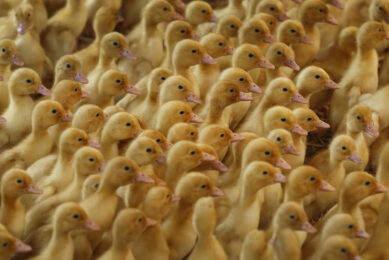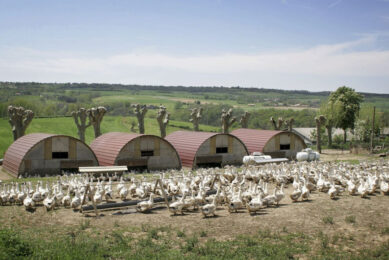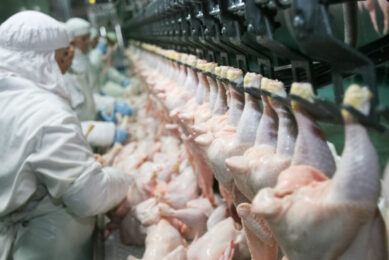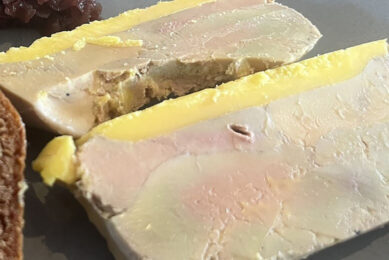Duck producers move forward together
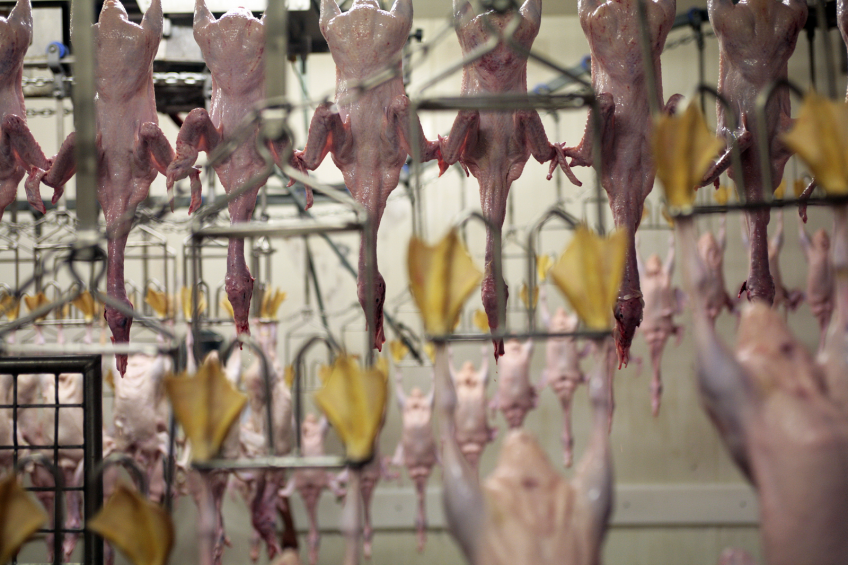
In September the activities, personnel and brands; Kronenhof and Royal Duck of VSE will move to Tomassen Duck-To. With this, the end of the cooperative duck meat producer in the Dutch Harderwijk is in sight. When the slaughterhouse and the ground is sold, the cooperation will be dissolved.
For more than 40 years’ cooperative VSE in Harderwijk and Tomassen Duck-To in Ermelo operated only a stone’s throw away from each other. But this is to end when, VSE, founded in 1952, and Tomassen Duck-To, in 2014 halve a century old, join their (slaughter) activities as from 1 September. The personnel and the brands Kronenhof and Royal Duck will go to Tomassen Duck-To. Joining forces for a stronger duck sector is the main thrust for this step, according to the directors of both companies.
VSE – slaughtering in old building
The Verenigde Slachtpluimvee Export (VSE) is located in a building in the centre of the city Harderwijk. Director Jan van de Weerd (62) did not have luck on his side when he entered the office for the first time two years ago. In September the Russian boycott came into force and in November avian flu was accompanied by transport and selling restrictions. Particularly since the Russian intervention the duck market has been difficult to poor for several years. Dutch duck producers are experiencing serious competition from Polish and Hungarian duck (meat), which cannot be transported into Russia. When Van de Weerd took on the leadership two years ago, VSE had large stocks. He decided to limit production and eliminate stocks. Later VSE increased the number of slaughters, by attracting fatteners and by custom slaughtering Danish ducks. To compete with Polish and Hungarian ducks VSE implemented a quality line and a quality bonus for duck farmers. VSE had to deal with a future problem: the slaughterhouse – the building is in rather poor condition. The equipment is still good and functional. Van de Weerd: “The building needs a facelift and the freezing capacity must increase.” VSE had three options: staying in the existing building, building a new building elsewhere or merge with Tomassen Duck-To. “The board and the general meeting unanimously chose the latter.” As of 1 September the activities, personnel and the two brands shall move to the producer in Ermelo. Whether from this date on the slaughter of ducks in Harderwijk will stop, depends on what will happen to the building. “We expect the municipality will buy it. We are at an advanced stage of negotiations,” says De Weerd, who will be operational director at Tomassen Duck-To after the merger. As long as the sale of the slaughterhouse is pending, the VSE slaughterhouse can remain operational as a second slaughter location – to slaughter ducks intended for further processing or cutting up for instance. This happens in-line.
“Synergy and efficiency advantages” For Jaap Maarsingh, duck farmer in Zeewolde and chairman of the farmers union of duck farmers, the merger of the two duck integrations doesn’t come as a surprise. “They were not direct competitors in the market, the one focusing on fresh cut ups, the other on frozen whole birds. They also made some exchanges and Tomassen Duck-To has taken care of VSE’s transport for more than a year. Slaughtering at one location, in one building, one entry point, may provide synergy and efficiency benefits. I’m thinking of feed buying for instance. Hopefully other fatteners also benefit from that.” Maarsingh, who is also an arable farmer, refers to a merger in the sugar industry where Cosun and CSM joined forces almost a decade ago, leaving only one producer. “This was a great success for the growers.” The difference however is that the private producer was merged with the cooperative. In practice not much will actually change, he expects. “We are still a small industry.” |
Tomassen Duck-To: Thai-Dutch combination
Tomassen Duck-To is preparing itself for the merger and expansion. In their building in Ermelo preparations are made for the arrival of 38 VSE employees and VSE ducks which are ready for slaughter. Director Gertjan Tomassen (46) expects to be able to process the extra supply of meat ducks by changing the 5 slaughter days of 7.5 hours into 5 slaughter days of 12 hours.

The personnel will work 4 days of 9.5 hours instead of 5 days of 7.5 hours. Tomassen discussed this with all employees and nearly everyone agreed on the change. Since 2007 Tomassen Duck-To is part of the BR Group, which also includes Bangkok Ranch in Thailand. The BR Group is listed; one third of the group’s capital is in shares. Production of the group is four times as big in Thailand as it is in the Netherlands. This will change with the merger with VSE. The BR Group is the fifth duck producer worldwide, after four producers in China. About the collaboration with VSE, Tomassen says there were previous talks between both companies. They spoke for the first time right after the avian influenza outbreak in 2003. And also after that they raised the topic. About a year and a halve ago both companies decided that Tomassen Duck-To would take care of all VSE’s transport of hatching eggs, day-old chicks and finished ducks. Tomassen: “That was the initial impetus for the collaboration we are entering now.”

Export orders
According to Van de Weerd both companies also collaborated in order to fill up export orders. The fact that both companies were able to exist alongside (and in each other’s vicinity) is partly due to the fact they are not producing the same products, which doesn’t make them real rivals. Tomassen Duck-To almost exclusively supplies whole duck and solely frozen. VSE cuts up approximately a quarter of the supply and sells 10% fresh. The slaughter weight of their ducks is also slightly higher on average. “We met every now and then on certain selling markets. This merger allows us to slaughter more efficiently, so with a lower cost price. This makes us more competitive. Plus, we can make the, demand-driven, transition from whole duck to cut up and from fresh to frozen. And get the best price this way. “When it comes to competition, Tomassen points at Poland and Hungary. They can produce with a 10% to 15% lower cost price. We can compensate, in part, with quality, many buyers choose the Dutch duck of better quality. But the price difference can’t become too large. Tomassen and Van de Weerd agree on the importance of the merger: “For the Duck meat industry this merge embodies the continuity of the sector.”




